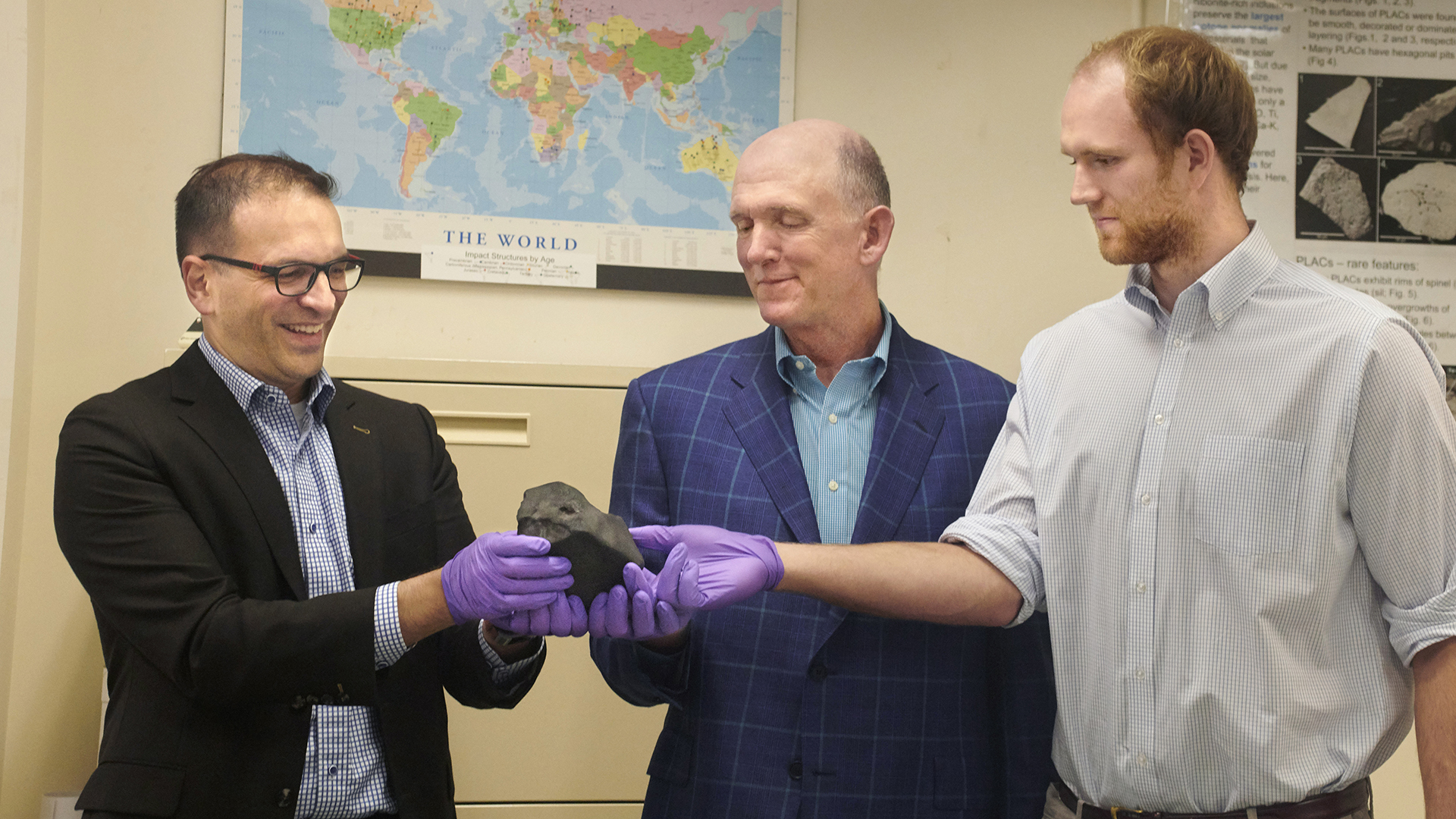'Cosmic Mudball Meteorite' Smells Like Brussels Sprouts, Finds New Home at Museum
It smells as good as it looks.

It looks like a block of mud and smells (some say) like pungent vegetables. Nonetheless, the latest addition to the collection at the Field Museum of Natural History in Chicago is a wondrous thing — a visitor from across the cosmos that fell to Earth earlier this year as a meteorite.
This piece of the so-called cosmic mudball meteorite — dubbed Aguas Zarcas, for the region of Costa Rica where it landed — weighs about 4 lbs. (1.8 kilograms). Unlike many rocky or metallic meteorites, it has a distinctive aroma that is somewhat like that of cooked Brussels sprouts, Field Museum representatives said in a statement.
This odor comes from organic compounds such as amino acids. Billions of years ago, malodorous meteorites like this were likely what seeded Earth with the building blocks for life, and Field Museum scientists will study the smelly space rock for clues about the materials that shaped our solar system, according to the statement.
Related: Space-y Tales: The 5 Strangest Meteorites
Aguas Zarcas fell to Earth on April 23, blazing across the skies over Costa Rica's Alajuela province as a spectacular fireball, The Meteoritical Society reported. The meteorite broke apart during entry; one fast-moving piece weighing about 41 ounces (1,162 grams) smashed into a house, and another fragment weighing around 10 ounces (280 g) struck a doghouse, according to the report.
Approximately 50,000 meteorites have been detected on Earth. Of that number, 99.8% come from asteroids; the rest are rocks blasted off Mars and our moon by meteor collisions, NASA says. There are three main types of meteorites: Either they're mostly iron, mostly stony or a mix of stone and metal in nearly equal quantities, according to NASA.
The mudball is a type of stony meteorite known as a carbonaceous chondrite; these make up only about 4% of all meteorites that reach Earth, said Philipp Heck, the Robert A. Pritzker Associate Curator of Meteoritics and Polar Studies at the Field Museum. They're an unusually rare type, because in most parent asteroids, intense heating over time changes the asteroid's chemistry and destroys amino acids, Heck told Live Science in an email.
Sign up for the Live Science daily newsletter now
Get the world’s most fascinating discoveries delivered straight to your inbox.
Though many carbonaceous chondrite meteorites contain organic compounds, many of them become contaminated by terrestrial amino acids once they collide with Earth, Heck said.

What lends the mudball its Brussels sprout scent? "We smell the organic volatile compounds that leave the meteorite," Heck explained. "Different meteorites have different volatile inventories, mainly because they were 'cooked' to different degrees for different amounts of time on their parent asteroids. That causes them to smell differently."
Another carbonaceous chondrite meteorite, perhaps the most well-studied in the world, is the Murchison meteorite, which is also in the Field Museum's collection. This space rock fell in 1969 and has "a tar-like smell," Heck said. "Aguas Zarcas smells sweeter to me."
But however tantalizing a space rock may smell, geologists never taste them (yes, geologists sometimes lick their subjects as a diagnostic test).
"Most geologists learn to lick their rocks. This is what I learned in basic geology class at the university. However, we refrain from licking meteorites," Heck said in the email.
"First, because we don't want to contaminate them. Second, because we don't want to expose them to liquid water, which degrades them, particularly the metal and water-soluble minerals and organics. And third, because some meteorites contain harmful materials when eaten," he explained.
- When Space Attacks: The 6 Craziest Meteor Impacts
- The 7 Strangest Asteroids: Weird Space Rocks in Our Solar System
- Photos: The World's 6 Most Famous Rocks
Originally published on Live Science.


Mindy Weisberger is an editor at Scholastic and a former Live Science channel editor and senior writer. She has reported on general science, covering climate change, paleontology, biology and space. Mindy studied film at Columbia University; prior to Live Science she produced, wrote and directed media for the American Museum of Natural History in New York City. Her videos about dinosaurs, astrophysics, biodiversity and evolution appear in museums and science centers worldwide, earning awards such as the CINE Golden Eagle and the Communicator Award of Excellence. Her writing has also appeared in Scientific American, The Washington Post and How It Works Magazine. Her book "Rise of the Zombie Bugs: The Surprising Science of Parasitic Mind Control" will be published in spring 2025 by Johns Hopkins University Press.









